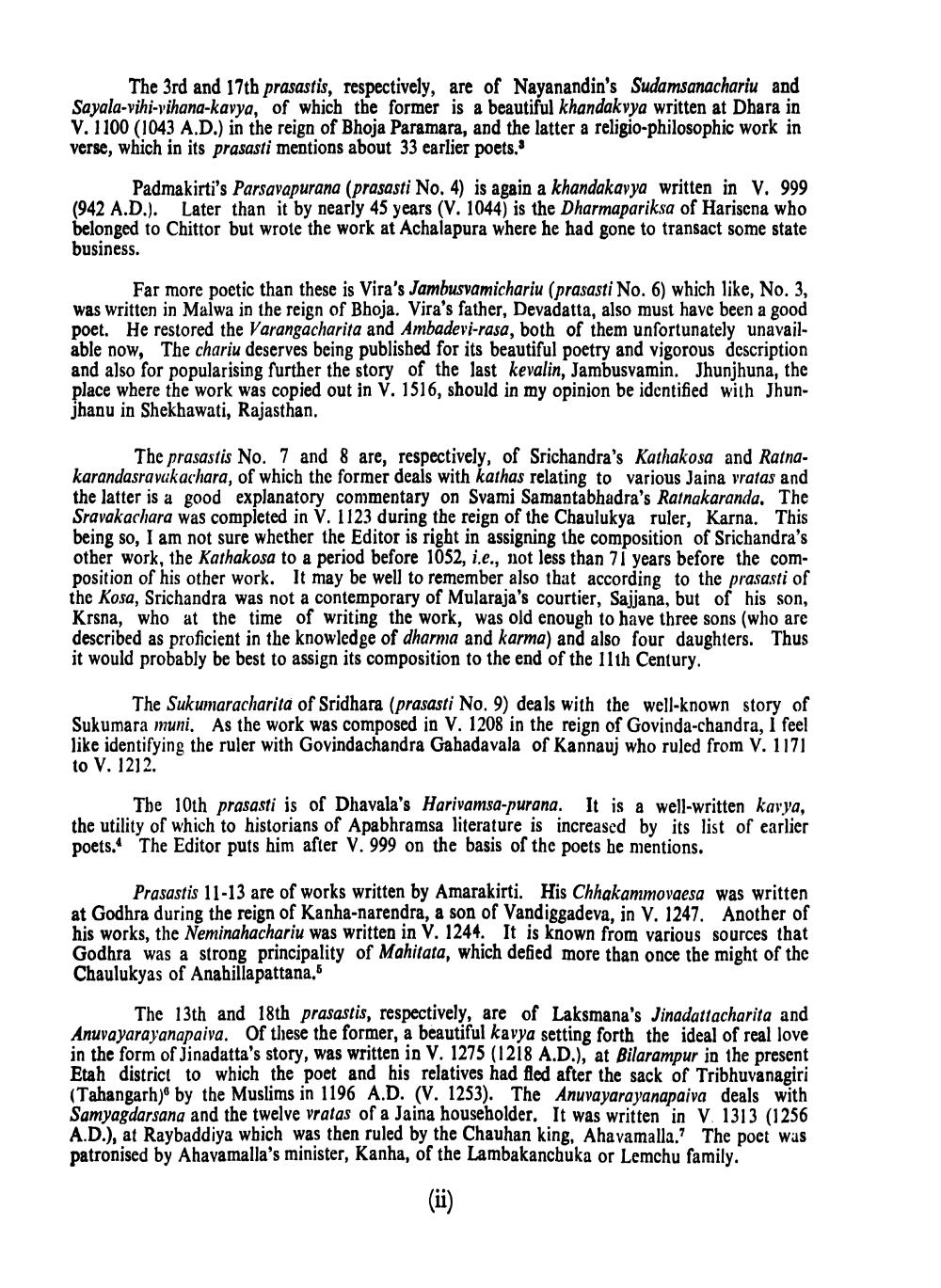________________
The 3rd and 17th prasastis, respectively, are of Nayanandin's Sudamsanachariu and Sayala-vihi-vihana-kavya, of which the former is a beautiful khandakvya written at Dhara in V. 1100 (1043 A.D.) in the reign of Bhoja Paramara, and the latter a religio-philosophic work in verse, which in its prasasti mentions about 33 earlier poets.
Padmakirti's Parsavapurana (prasasti No. 4) is again a khandakavya written in V. 999 (942 A.D.). Later than it by nearly 45 years (V. 1044) is the Dharmapariksa of Harisena who belonged to Chittor but wrote the work at Achalapura where he had gone to transact some state business.
Far more poetic than these is Vira's Jambusvamichariu (prasasti No. 6) which like, No. 3, was written in Malwa in the reign of Bhoja. Vira's father, Devadatta, also must have been a good poet. He restored the Varangacharita and Ambadevi-rasa, both of them unfortunately unavailable now, The chariu deserves being published for its beautiful poetry and vigorous description and also for popularising further the story of the last kevalin, Jambusvamin. Jhunjhuna, the place where the work was copied out in V. 1516, should in my opinion be identified with Jhunjhanu in Shekhawati, Rajasthan.
The prasastis No. 7 and 8 are, respectively, of Srichandra's Kathakosa and Ratnakarandasravakachara, of which the former deals with kathas relating to various Jaina vratas and the latter is a good explanatory commentary on Svami Samantabhadra's Ratnakaranda. The Sravakachara was completed in V. 1123 during the reign of the Chaulukya ruler, Karna. This being so, I am not sure whether the Editor is right in assigning the composition of Srichandra's other work, the Kathakosa to a period before 1052, i.e., not less than 71 years before the composition of his other work. It may be well to remember also that according to the prasasti of the Kosa, Srichandra was not a contemporary of Mularaja's courtier, Sajjana, but of his son, Krsna, who at the time of writing the work, was old enough to have three sons (who are described as proficient in the knowledge of dharma and karma) and also four daughters. Thus it would probably be best to assign its composition to the end of the 11th Century.
The Sukumaracharita of Sridhara (prasasti No. 9) deals with the well-known story of Sukumara muni. As the work was composed in V. 1208 in the reign of Govinda-chandra, I feel like identifying the ruler with Govindachandra Gahadavala of Kannauj who ruled from V. 1171
to V. 1212.
The 10th prasasti is of Dhavala's Harivamsa-purana. It is a well-written karya, the utility of which to historians of Apabhramsa literature is increased by its list of earlier poets. The Editor puts him after V. 999 on the basis of the poets he mentions.
Prasastis 11-13 are of works written by Amarakirti. His Chhakammovaesa was written at Godhra during the reign of Kanha-narendra, a son of Vandiggadeva, in V. 1247. Another of his works, the Neminahachariu was written in V. 1244. It is known from various sources that Godhra was a strong principality of Mahitata, which defied more than once the might of the Chaulukyas of Anabillapattana."
The 13th and 18th prasastis, respectively, are of Laksmana's Jinadattacharita and Anuvayarayanapaiva. Of these the former, a beautiful kavya setting forth the ideal of real love in the form of Jinadatta's story, was written in V. 1275 (1218 A.D.), at Bilarampur in the present Etah district to which the poet and his relatives had filed after the sack of Tribhuvanagiri (Tahangarh) by the Muslims in 1196 A.D. (V. 1253). The Anuvayarayanapaiva deals with Samyagdarsana and the twelve vratas of a Jaina householder. It was written in V. 1313 (1256 A.D.), at Raybaddiya which was then ruled by the Chauhan king. Ahavamalla." The poet was patronised by Ahavamalla's minister, Kanha, of the Lambakanchuka or Lemchu family.
(ii)




